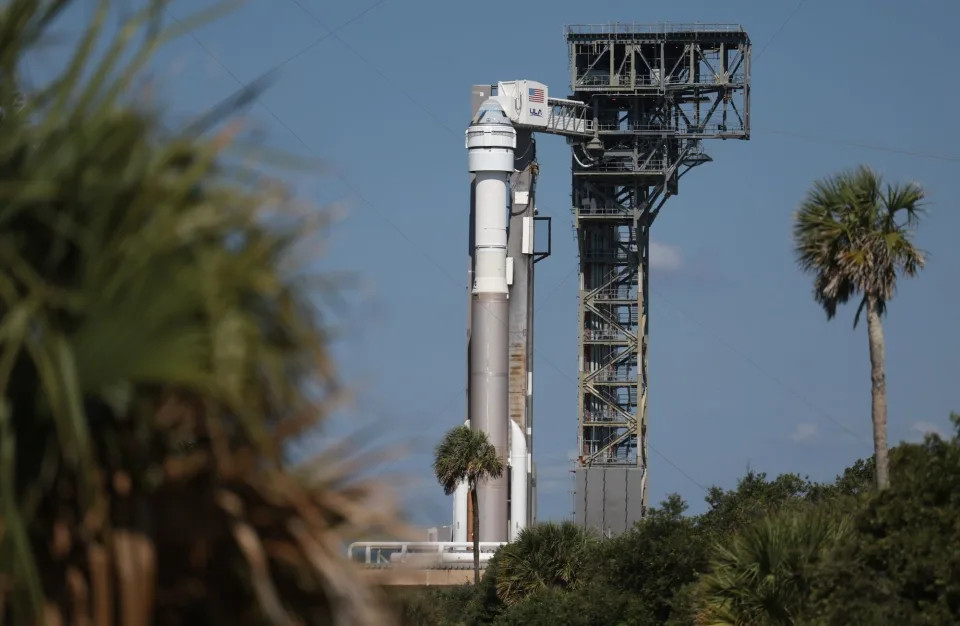The flight marked the first time Boeing’s problem-plagued Starliner capsule carried humans to space after years of delays and cost overruns, and also the first time a United Launch Alliance rocket flew a crewed mission.
Boeing’s CST-100 Starliner took off on the shoulders of ULA’s Atlas V at Florida’s Cape Canaveral at 10:52 a.m. local time, with a wave of cheers erupting from the lawn outside of the NASA press site as the rocket thundered off the launchpad.
The capsule, carrying veteran NASA astronauts Sunita “Suni” Williams and Barry “Butch” Wilmore, separated from the ULA rocket about 15 minutes into the mission. Roughly half an hour after launch, Starliner fired its thrusters and reached a stable orbit — achieving a long-awaited milestone for the program.
“You’re seeing lots of happy faces and cheers,” Brandi Dean, a public affairs officer at NASA, said on a live webcast. “Everybody is glad to see Starliner is safely in orbit.”
The drama-free launch provided some rare good news for Boeing, which has been grappling with a crisis centered on its marquee 737 Max jetliner.
Boeing shares pared earlier losses and were up less than 1% at 1:20 p.m. in New York.
Starliner will perform a series of maneuvers to put it on course to link up with the space station around 12:15 p.m. Florida time on Thursday for a roughly week-long stay.
Wednesday’s test is the culmination of years of delays caused by technical glitches and failures with the Starliner craft. Those include an earlier botched 2019 test flight and fresh concerns over the past month of a still-unresolved helium leak NASA is monitoring throughout the mission.
After the craft arrived in orbit, teams identified two additional helium leaks, a NASA spokesperson said by email. The spacecraft is in a “stable configuration” as officials evaluate the data while monitoring the leaks, the spokesperson said.
A Boeing spokesperson said the company is monitoring the situation but it didn’t appear to be an issue for docking.
NASA is using the flight to prove Starliner can safely carry people to and from the ISS under the US space agency’s Commercial Crew Program.
“Today, it all lined up,” Boeing executive Mark Nappi told reporters after the morning launch, noting a “perfect countdown and launch.” But Nappi laid out several key milestones before the vehicle is certified for regular spaceflight. Those include docking and undocking at the orbiting research laboratory and the capsule’s safe return to Earth.
In 2014, NASA awarded Boeing $4.2 billion and Elon Musk’s SpaceX $2.6 billion to create vehicles to ferry the agency’s astronauts to space. While Starliner has fallen seven years behind schedule, SpaceX has launched nine separate crews to the space station for NASA since 2020.
While this test is largely focused on Starliner, it was also an important moment for ULA. The Atlas V rocket had 99 previous successful launches before it ever carried astronauts. Boeing is also one of two parent companies of ULA, along with rival Lockheed Martin Corp.
“We are very proud to join the human spaceflight community,” ULA Chief Executive Officer Tory Bruno told reporters.
Boeing and NASA first tried to launch on May 6, but the flight was halted hours before takeoff due to an oddly behaving pressure valve in the Atlas V rocket. Boeing further delayed the launch by a few weeks to investigate the helium leak.
A June 1 attempt was called off less than four minutes before takeoff after a launch computer needed for the final stages of flight was slow to respond.
Despite the earlier setbacks, the mission appeared to go off without a hitch. But NASA said it was keeping an eye on so-called sublimators used to cool the vehicle down during the flight. The components are running out of water a little more quickly than expected, but Starliner’s radiators should be able to take over, mitigating the problem.
Ahead of Wednesday’s launch, Wilmore noted the American flags he’d seen earlier that day, including on the Atlas V rocket itself.
“We think that represents unity and resilience and unified efforts for the common good,” he said minutes before the launch. “Suni and I are honored to share this dream of spaceflight with each and every one of you.”
